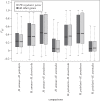Genomics of homoploid hybrid speciation: diversity and transcriptional activity of long terminal repeat retrotransposons in hybrid sunflowers
- PMID: 24958919
- PMCID: PMC4071519
- DOI: 10.1098/rstb.2013.0345
Genomics of homoploid hybrid speciation: diversity and transcriptional activity of long terminal repeat retrotransposons in hybrid sunflowers
Abstract
Hybridization is thought to play an important role in plant evolution by introducing novel genetic combinations and promoting genome restructuring. However, surprisingly little is known about the impact of hybridization on transposable element (TE) proliferation and the genomic response to TE activity. In this paper, we first review the mechanisms by which homoploid hybrid species may arise in nature. We then present hybrid sunflowers as a case study to examine transcriptional activity of long terminal repeat retrotransposons in the annual sunflowers Helianthus annuus, Helianthus petiolaris and their homoploid hybrid derivatives (H. paradoxus, H. anomalus and H. deserticola) using high-throughput transcriptome sequencing technologies (RNAseq). Sampling homoploid hybrid sunflower taxa revealed abundant variation in TE transcript accumulation. In addition, genetic diversity for several candidate genes hypothesized to regulate TE activity was characterized. Specifically, we highlight one candidate chromatin remodelling factor gene with a direct role in repressing TE activity in a hybrid species. This paper shows that TE amplification in hybrid lineages is more idiosyncratic than previously believed and provides a first step towards identifying the mechanisms responsible for regulating and repressing TE expansions.
Keywords: Helianthus; RNAseq; genome evolution; hybridization; transposable elements.
© 2014 The Author(s) Published by the Royal Society. All rights reserved.
Figures







References
-
- Winge O. 1917. The chromosomes. Their numbers and general importance. Comp. Rend. Travaux Lab. Carlsberg Copenhague 13, 131–275.
-
- Stebbins GL. 1950. Variation and evolution in plants. New York, NY: Columbia University Press.
-
- Grant V. 1981. Plant speciation. New York, NY: Columbia University Press.
-
- Arnold ML. 1997. Natural hybridization and evolution. Oxford, UK: Oxford University Press.
-
- Soltis DE, Buggs RJA, Doyle JJ, Soltis PS. 2010. What we still don't know about polyploidy. Taxon 59, 1387–1403.
Publication types
MeSH terms
Substances
LinkOut - more resources
Full Text Sources
Other Literature Sources

